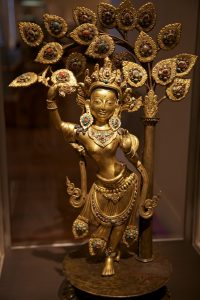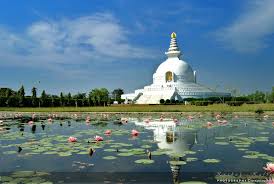Lumbini: Sacred Site of Buddha’s Birth
The sacred site of Buddha’s birth is located in the district of Kapilvastu, Nepal[i].The town of Kapilvastu is sandwiched between the two cities of Kosala on the western side and Koliyas on the eastern side[ii]
Lumbini does not have any different names but is sometimes mentioned as the Lumbini Development Zone[i]. Lumbini is also frequently called Kapilvastu, which was named after the saint Kapila in the early 6th century B.C[ii].
Mythological History
The Chinese translation of the Buddhist texts mythological and religious tale starts off with Maya, who is Buddha’s mother and the wife of King Shuddhodana, who was not able to have children for 20 years[i].

Jean- Marie Hullot Maya Devi figurine www.wikipedia.com
King Shuddhodana was the ruler of the Shakya clan that controlled the small town in Nepal. Maya, his wife, was transported into a dream taking her to a Himalayan lake, where she was bathed and fragranced[ii]. While this was happening, she was hoisted onto a white six-tusked elephant that circled her three times[iii]. The white elephant ends up being very significant in the Buddhist religion along with the Chinese mythological history representing motherhood[iv]. When Maya had woken up from her dream she was pregnant[v]. The white elephant had impregnated her with the soon to be born Buddha[vi]. Months later the Buddha was born in the Lumbini garden under a tree. A week after she gave birth Maya died and became part of the divine[vii]. When Buddha turned 29 and crossed over into experiencing paranirvana, which is his final death and a release from the cycle of suffering, his mother Maya came down to see him go[viii]. Buddha consoled her with his words and comforted her that it was okay to let him go.
Official History
Next to Kapilvastu is a town called Kosala, which is larger and has a bigger population[i]. King Virudhaka, the ruler of Kosala led his army into Kapilvastu in 545 BC and destroyed the city and all the people in it[i]. King Virudhaka attacked Kapilvastu because it was the center of the Shakyas clan. Virudhaka learned that his mother came from the Shakyas clan and had lied to his father about it so he wanted revenge.
After the destruction of the city, King Virudhaka of Kosala
took over control and made it their own[ii]. The town was left in shambles and the remaining Shakyas fled from the city[iii]. When the Buddha and his disciple Anada visited they were shocked and horrified[iv]. When King Ajatastatru of Magadha heard of the destruction from the Buddha he took charge by attacking Kosala[v]. King Ajatasatru burnt Virudhaka and his minister Ambarisha alive and combined Kosala and Kapilvastu together into his reign[vi].
Founding and Central Figures
This location was founded by Emperor Ashoka who visited the area in 248 BCE[i]. He claimed and made this site historical because he erected a pillar in Lumbini stating that his son was born here called the Ashoka pillar[ii] The important figures of this site who are praised are the Buddha and his mother Maya Devi.
Practices
The Buddha was born in 563 BCE on the day of Baisakh Purnima, which is the full moon of May[i]. On the day of Chaitra Purnima, which is the full moon of March-April, there is a month long celebration that happens leading up to the Baisakh Purnima[ii].
There is a main festival of Buddha Jayanti which is another name for birth day, and Lumbini Day, which are celebrated together to worship the Buddha idol[iii]. During this celebration there is a procession of the idol positioned on a chariot along with songs, dances, prayers and chants taking place around it[iv].
There is another ritual practice that takes place in appreciation for the Ashoka pillar that stands next to the temple[v]. The practice is offering shaved hair at the pillar on the unapanayan occasion, which is the head-shaving ceremony of a child[vi]. The pillar is viewed to be keeping guard over the people.
[i] Joshi, Anil “Lumbini and the Spiritual” Nepal, Culture and Heritage 2010
[ii] Joshi, Anil “Lumbini and the Spiritual” Nepal, Culture and Heritage 2010
[iii] Joshi, Anil “Lumbini and the Spiritual” Nepal, Culture and Heritage 2010
[iv] Joshi, Anil “Lumbini and the Spiritual” Nepal, Culture and Heritage 2010
[v] Joshi, Anil “Lumbini and the Spiritual” Nepal, Culture and Heritage 2010
[vi] Joshi, Anil “Lumbini and the Spiritual” Nepal, Culture and Heritage 2010
[i] Violatti, Christian “Kapilavastu” 2013
[ii] Violatti, Christian “Kapilavastu” 2013
[i][i][i] Singh, Harischandra Lal. “Buddhism in Nepal” 1999. Pg 5
[ii] Singh, Harischandra Lal. “Buddhism in Nepal” 1999. Pg 11
[iii] Singh, Harischandra Lal. “Buddhism in Nepal” 1999. Pg 11
[iv] Singh, Harischandra Lal. “Buddhism in Nepal” 1999. Pg 11
[v] Singh, Harischandra Lal. “Buddhism in Nepal” 1999. Pg 11
[vi] Singh, Harischandra Lal. “Buddhism in Nepal” 1999. Pg 11
[i] Violatti, Christian “Kapilavastu” 2013
[i] “Dharma Echoes of Mother Maya” Columbia University Press, 2015
[ii] “Dharma Echoes of Mother Maya” Columbia University Press, 2015
[iii] “Dharma Echoes of Mother Maya” Columbia University Press, 2015
[iv] “Dharma Echoes of Mother Maya” Columbia University Press, 2015
[v] “Dharma Echoes of Mother Maya” Columbia University Press, 2015
[vi] “Dharma Echoes of Mother Maya” Columbia University Press, 2015
[vii] “Dharma Echoes of Mother Maya” Columbia University Press, 2015
[viii] “Dharma Echoes of Mother Maya” Columbia University Press, 2015
[i] Buddha’s birthplace facing major environmental threat: Experts” Newstrack India 2009
[ii] Singh, Harischandra Lal. “Buddhism in Nepal” 1999. Pg 4
[i] ASHER, FREDERICK. 2009. “FROM PLACE TO SITE: LOCATIONS OF THE BUDDHA’S LIFE.
[i] ASHER, FREDERICK. 2009. “FROM PLACE TO SITE: LOCATIONS OF THE BUDDHA’S LIFE”. Artibus Asiae
[ii] ASHER, FREDERICK. 2009. “FROM PLACE TO SITE: LOCATIONS OF THE BUDDHA’S LIFE”. Artibus Asia


